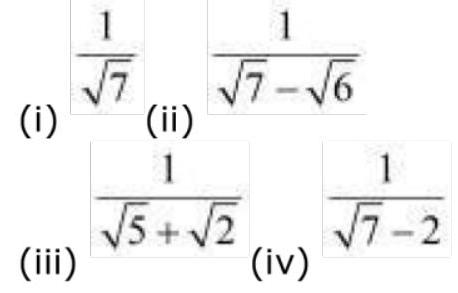Chapter 01 Number Systems Exercise-04
EXERCISE 1.4
1. Classify the following numbers as rational or irrational:
(i)
(ii)
(iii)
(iv)
(v)
Show Answer
Solution
(i)
As the decimal expansion of this expression is non-terminating non-recurring, therefore, it is an irrational number.
(ii)
As it can be represented in
(iii)
(iv)
As the decimal expansion of this expression is non-terminating non-recurring, therefore, it is an irrational number. (
As the decimal expansion of this expression is non-terminating non-recurring, therefore, it is an irrational number.
2. Simplify each of the following expressions:
(i)
(ii)
(iii)
(iv)
Show Answer
Solution
3. Recall,
Show Answer
Solution
There is no contradiction. When we measure a length with scale or any other instrument, we only obtain an approximate rational value. We never obtain an exact value. For this reason, we may not realise that either
the
4. Represent
Show Answer
Solution
Mark a line segment

(i)
perpendicular to line
Taking B as centre and BE as radius, draw an arc in tersecting number line at

5. Rationalise the denominators of the following:
(i)
(ii)
(iii)
(iv)
Show Answer
Solution
(i)
(ii)










